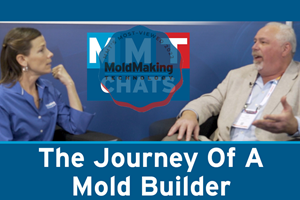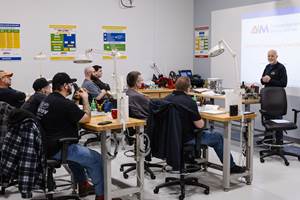
Westminster Tool Manufacturing Engineer Eddie Graff and Mantle Senior Application Engineer Scott Kraemer take turns presenting a new precision metal 3D printing technology and the results of testing Mantle's H13 and P20 tool steel materials—including stability, machinability and tolerances.
MoldMaking Technology’s 2021 Leadtime Leader Award winner partnered up and performed rigorous testing on Mantle's tool steel materials via Mantle's 3D printing technology for tool building.
Results include the materials meeting industry requirements for stability and machining and that printed cavity set replacements can impact lead times and cycle times.
No surprise that this webinar provoked a lot of questions. Here is a list to whet your appetite about what you can learn by watching this free webinar:
- Can you print threaded holes or do you need to tap after printing?
- If machining is required, anyway, what are the advantages (cost vs machining; timing)?
- Are you using inert gas during the sinter? If so, what gas and how much during a sinter process?
- Can these materials be welded if needed?
- If sintering is done post printing, how do you counteract shrinkage and subsequent dimensional changes?
- Does the insert move or shrink during heat treatment?
- Are you experiencing material growth or shrinkage with the H13 steel when heat treated for higher RC?
- What is the minimum wall thickness that can be accurately achieved? What is the sintering atmosphere and peak temp? Would you consider this a technology that would be a good fit for micro/mini Injection mold inserts for MIM, CIM, and plastics (multi-slide molds, part fits within .100" cube)?
- What is the print volume for this process?
- What is the maximum size of the mold inserts?
- Is there any porosity (good for localized venting / bad for LSR molding)?
- Do you use parting line surfaces as-printed or do you allow stock for finish grind?
- What are support requirements involved with this process? Are they similar to traditional FDM printing?
- what is the cost of a machine? Do you offer printing as a service to help us cost justify a machine purchase in future?
- Have you tried printed holes or features for location and then machine to tolerance to save on material scrap?
- Confidence in tiny features? Recommend inserting?
- Can you provide conformal cooling channels (overhanging details)?
- Does the Mantle printing method allow for integral (not post-processed) conformal cooling channels?
- What type of tooling do you do and where will Mantle's technology be relevant? Where will it not be relevant?
- What is your build size?
- Why did you start with H13 and P20?
- What materials are you considering next?
- When will printers be available for purchase?
- What other R&D projects have you done with Mantle since completing these initial projects?
- With the medical helical cone part made with a Mantle prototype insert, what prevents production tooling from being made by Mantle printing?
- What does this mean for the future of mold making with additive compared to traditional steel?
- Is all that material printable in one cartridge load? If not, does the dimensional consistency change when using multiple material cartridges?
Click here to access this free webinar, and visit https://www.moldmakingtechnology.com/webinars for all archived webinars.
Related Content
MMT Chats: California Mold Builder Discusses the Difficulties with Silicone Molding and the Power of the Magic 8 Ball
MoldMaking Technology Editorial Director Christina Fuges sits down with M.R. Mold President and Owner, Rick Finnie, to discuss how he began his moldmaking career, M.R. Mold's LSR Education, and the struggles of working with silicone. This episode is brought to you by ISCAR with New Ideas for Machining Intelligently.
Read MoreUnique Mold Design Apprenticeship Using Untapped Resources
To help fill his mold design skills gap, Jeff Mertz of Anova Innovations, is focused on high schools and underprivileged school districts, a school that has lower graduation and college entrance rates. The goal is a student-run enterprise.
Read MoreMold Maintenance Continues to Matter: Enhanced Training Program in a New Facility
I attended a MoldTrax mold maintenance workshop in 2019 and shared my experiences, and despite changes in ownership, the workshop's remarkable value endures, as discussed in a recent Q&A with the current leadership.
Read MoreTackling a Mold Designer Shortage
Survey findings reveal a shortage of skilled mold designers and engineers in the moldmaking community, calling for intervention through educational programs and exploration of training alternatives while seeking input from those who have addressed the issue successfully.
Read MoreRead Next
How to Use Continuing Education to Remain Competitive in Moldmaking
Continued training helps moldmakers make tooling decisions and properly use the latest cutting tool to efficiently machine high-quality molds.
Read MoreHow to Use Strategic Planning Tools, Data to Manage the Human Side of Business
Q&A with Marion Wells, MMT EAB member and founder of Human Asset Management.
Read MoreAre You a Moldmaker Considering 3D Printing? Consider the 3D Printing Workshop at NPE2024
Presentations will cover 3D printing for mold tooling, material innovation, product development, bridge production and full-scale, high-volume additive manufacturing.
Read More








.jpg;maxWidth=300;quality=90)












